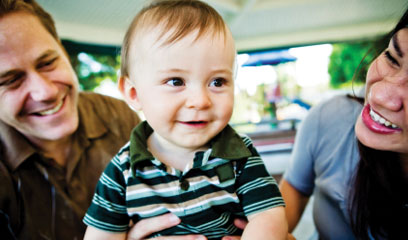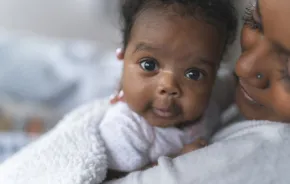 It starts earlier than you might think: Babies first begin learning language by listening to their mother’s voice while still in the womb.
It starts earlier than you might think: Babies first begin learning language by listening to their mother’s voice while still in the womb.
“That’s why when a baby is born, she prefers to hear her mother’s language and her mother’s voice,” says Rick McKinnon, Ph.D., an early learning specialist in Olympia.
Reading, singing, telling stories and talking to your unborn baby give her a head start on talking, says McKinnon. By continuing to do so after birth, you’re not only encouraging your baby's speech development, you’re developing a social connection and putting your baby in a good position for acquiring literacy. Learning to read is directly related to a child’s verbal and auditory abilities, McKinnon says. “If a child has developed basic language skills by kindergarten, then when that child learns to read, the process will go smoothly.” Not only that, but when a child is able to talk, it can cut down on the frustration both babies and parents experience. If a baby can’t communicate with you, they may act out.
Encouraging babies to talk
Your baby’s first word may come around the age of 12 months, according to Angela Kitzmiller, a speech language pathologist at Mary Bridge Children’s Hospital in Tacoma. “This may only be a word approximation, but nevertheless it’s the baby’s attempt at talking,” she says.
Kitzmiller says you can encourage early speech in several ways, some of which will have the added benefit of strengthening the bond between you and your baby. A mother’s response to a baby’s cries sets the tone for later development and helps develop a means of communication. During the first few months, crying is the major component of a baby’s communication system. When you respond, and your baby realizes that she is being heard, she’ll also feel that the world is a safe place where her needs will be met, according to Kitzmiller.
Although talking with a very young baby who doesn’t understand you may seem awkward, it’s important that you tell the child you’re noticing what she is doing. If you’re in a restaurant with an overhead fan, and your baby is looking at it, you can say, “That’s a fan” and “It’s turning.” The baby realizes you’ve noticed her interest in the fan and she’ll want to continue interacting with you, suggests McKinnon.
Asking questions of your baby may block the interaction. McKinnon recommends that you observe the baby to see what she’s interested in. If it’s a toy, use words and actions to show your baby how the toy works. “Push,” “pull,” “turn” and “open” are examples. But asking the baby complex questions and interrogating her doesn’t encourage early speech.
A great way to promote early speech is to enroll your baby in a play group in which she has to communicate with other children. With parents, a child can be lazy about talking, but when it comes to other children, she’ll have to come up with words. A community-based program that meets once a week works well, says Kitzmiller.
Reading is crucial
How you read to small children is more important than what you read, but pictures are essential, according to McKinnon. What’s really important is that the child is interested in the story. You can help her connect by talking about the pictures. Emphasize recognizable parts of the book that your child can identify with. Focus on smaller elements.
You can make books for your baby, using photos of familiar objects and people. Mount them on cardboard or poster board pages and put them together with string, ribbon or loose-leaf rings. Laminating them or using clear plastic sleeves protects these books from drool and spit-up.
“Reading a book is good language stimulation; the baby sees and hears the words in combination,” says McKinnon.
 Baby sign language
Baby sign language
Both Kitzmiller and McKinnon agree that using baby sign language has definite benefits — as long as the adult pairs the signs with words. For the baby, it’s easier to make the gross motor movements of signing than the finer movements of speech. “Babies can reliably sign at the age of 6 months,” says McKinnon. “Signing cuts down on frustration, and we aren’t in any danger of short-circuiting our baby’s language because we use signs.”
Most people’s only exposure to signing has been with the deaf community. Using signs with infants is fundamentally different and not an alternative to speech. Signing is a form of communication that helps infants and toddlers express their needs as soon as they are able, thus building a strong foundation for using speech, explains McKinnon.
Babies are programmed to learn and talk and, barring any developmental issues, they all do. If you have any concerns about your child, have their speech and hearing checked earlier rather than later. Hearing and speech go hand in hand.
Heather Larson is a freelance writer living in Tacoma.











